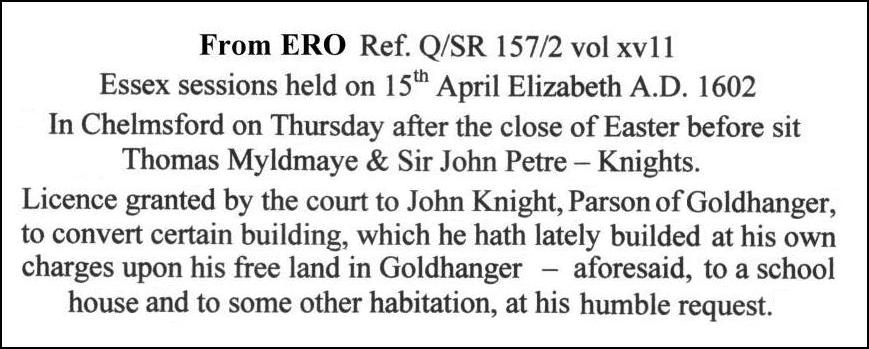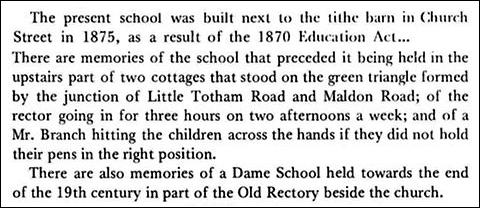The Pit Cottages
formerly on the triangle at
the junction of the Maldon Rd and Lt. Totham Rd.

an artist’s impression of the
cottages the only photograph seen
The Pit Cottages acquired their name from being built in a former brick pit (also called a clay pit) and were well below the general ground level. The cottages had a chequered history until they demolished in the early 1960s. This extract for the Essex Records Office indicates that the building was used as the village school as early as 1602…

and this extract from House of Commons papers
indicated that it may still have been in use as a school in 1833, as no other
building from that date has been identified as being used as a school…

Part
of a long article in The Essex Chronicle in 1937 entitled: “Your Essex at
Goldhanger” (and transcribed in Descriptions of
Goldhanger ) has interviews with elderly villagers were about their past,
and includes...

In Goldhanger - an Estuary
Village Maura
Benham wrote…

The 1906 sales brochure
offered “The Old School”
which was one of the Revd. C B Leigh’s many properties sold in that year…

The cottages appear on this
map included in the sales brochure
showing the cottages on the
north side of the triangle…

The cottages also appears on
many other old maps, including both the 1820 and
1838 Tithe Maps (reference 146). In the
Awards listings associated with these maps the cottages are identified in the
ownership of William Bentall, of Goldhanger Plough fame, and the tenants
were listed as Robert Wager and James Hume.
It is said that the cellar at the back of the cottages went under the road and was used by smugglers who were using the well established route between Goldhanger Creek and Tiptree Heath. In the late 1950s an Osborne’s bus fell through the road surface into the cellar, which is probably the reason why the cottages were then demolished. However, it was at a time when many cottages were lost in the village after being condemned by Maldon Council and pulled down, and being in an old clay pit the cottages were probably very damp.
In the 20th century the
cottages were privately owned and rented to tenants. There was a well and a
large Walnut Tree in the front garden. One of the last
to live in the cottages was Reuben Johnson who worked at both the garage
opposite the Church for George Stokes and also Frank Norton the baker. He used
to get up very early and cycle down to Norton’s bakery at 2 Fish St. where he
would get the fires going for the ovens and prepare the first bread of the day.
He would them cycle home for breakfast before returning to the garage for
opening time.
Two trees were planted on
the triangle in 1977 as part of the Queens Jubilee celebrations and they are
still flourishing.